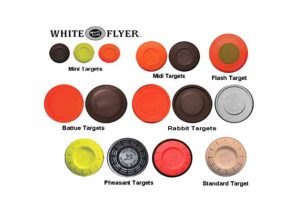How to Shoot the Different Sizes of Clay Targets
When it comes to clay pigeon shooting, one of the critical components that can affect your performance is the size of the clay targets. Whether you’re a beginner or a seasoned shooter, understanding the different sizes of clay targets can make a significant difference in honing your shooting skills and your overall shooting experience. Let’s embark on a journey to learn about the various clay target sizes, how they impact shooting techniques and their role in competitive shooting.
Understanding the Basics of Clay Pigeon Sizes
The size of a clay target is typically measured in diameter. The standard clay pigeon used for trap shooting and skeet shooting is approximately 110mm or 4.33 inches in diameter. These clay targets are designed to simulate the flight patterns of game birds, thus offering a realistic hunting experience in a controlled environment.

However, the size of clay targets can vary based on the particular shooting sport. Some sports, like sporting clays, use targets of different sizes to simulate different types of game. For instance, the mini target measures around 60mm and is used to replicate a distant bird, while the midi target, which is around 90mm, is designed to mimic a fast, low bird.
In addition to the standard, mini, and midi, there are a few more sizes, like the rabbit target, which is essentially a standard target laid on its side. The battue, a flat, thin disc, is larger than the standard target and is used in some shooting sports for variety.
Exploring the Different Types and Sizes of Clay Targets
There are several different types of clay targets available, each with their own unique sizes. The most common is the standard target, which as previously mentioned, is approximately 110mm in diameter. This target is used in most shooting sports due to its versatility and similarity to game birds.

Next, we have the mini target, measuring around 60mm in diameter, providing a greater challenge due to its smaller size and increased speed. Then, there is the midi target, which is slightly larger at around 90mm, simulating a faster, low bird.
There are also specialty targets like the rabbit target, which is a standard target laid on its side to mimic a ground-moving game. Battue targets, on the other hand, are flat and thin, measuring larger than standard targets, often used to introduce variety within shooting sports.
How Clay Target Sizes Impact Shooting Techniques
The size of a clay target can significantly impact the shooting technique used by participants. As the size of the target decreases, the difficulty in hitting the target increases, requiring more precise aim, timing, and quick reactions. Large targets provide an easier aim, but their speed and flight pattern may vary, adding a different element of challenge.

For instance, mini targets, due to their smaller size and faster speed, demand a quick reaction time from the shooter. Midi targets, being larger and slower, require a precise aim. Rabbit targets, on the other hand, move erratically on the ground, demanding a different shooting style altogether.
The size of the target can also influence the choice of shotguns and ammunition. Smaller targets may require a shotgun with a tighter choke to maintain an effective spread at longer distances, while larger targets can be effectively engaged with a wider choke.
The Role of Clay Target Sizes in Competitive Shooting
In competitive shooting, the size of clay targets plays a pivotal role in determining the difficulty level of the competition. Competitions often include a mix of different target sizes to test a shooter’s competence in various shooting skills, such as aim, timing, and reaction speed.
Smaller targets like mini and midi offer a greater challenge, testing the shooter’s precision and quick reaction times. Standard targets, meanwhile, test the shooter’s ability to accurately predict and follow the flight path. Rabbit and battue targets add unpredictability to the mix, providing a more comprehensive test of the shooter’s skills.
From the standard to the mini, each clay pigeon size presents its own unique set of challenges and requires different shooting techniques.
# # #


Comments